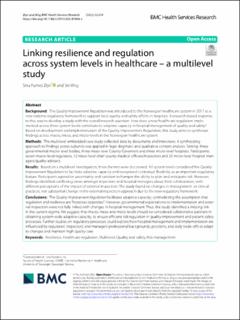| dc.contributor.author | Øyri, Sina Furnes | |
| dc.contributor.author | Wiig, Siri | |
| dc.date.accessioned | 2022-06-14T09:26:55Z | |
| dc.date.available | 2022-06-14T09:26:55Z | |
| dc.date.created | 2022-04-19T09:04:38Z | |
| dc.date.issued | 2022-04 | |
| dc.identifier.issn | 1472-6963 | |
| dc.identifier.uri | https://hdl.handle.net/11250/2998656 | |
| dc.description.abstract | Background
The Quality Improvement Regulation was introduced to the Norwegian healthcare system in 2017 as a new national regulatory framework to support local quality and safety efforts in hospitals. A research-based response to this, was to develop a study with the overall research question: How does a new healthcare regulation implemented across three system levels contribute to adaptive capacity in hospital management of quality and safety? Based on development and implementation of the Quality Improvement Regulation, this study aims to synthesize findings across macro, meso, and micro-levels in the Norwegian healthcare system.
Methods
The multilevel embedded case study collected data by documents and interviews. A synthesizing approach to findings across subunits was applied in legal dogmatic and qualitative content analysis. Setting: three governmental macro-level bodies, three meso-level County Governors and three micro-level hospitals. Participants: seven macro-level regulators, 12 meso-level chief county medical officers/inspectors and 20 micro-level hospital managers/quality advisers.
Results
Based on a multilevel investigation, three themes were discovered. All system levels considered the Quality Improvement Regulation to facilitate adaptive capacity and recognized contextual flexibility as an important regulatory feature. Participants agreed on uncertainty and variation to hamper the ability to plan and anticipate risk. However, findings identified conflicting views amongst inspectors and hospital managers about their collaboration, with different perceptions of the impact of external inspection. The study found no changes in management- or clinical practices, nor substantial change in the external inspection approach due to the new regulatory framework.
Conclusions
The Quality Improvement Regulation facilitates adaptive capacity, contradicting the assumption that regulation and resilience are “hopeless opposites”. However, governmental expectations to implementation and external inspection were not fully linked with changes in hospital management. Thus, the study identified a missing link in the current regime. We suggest that macro, meso and micro-levels should be considered collaborative partners in obtaining system-wide adaptive capacity, to ensure efficient risk regulation in quality improvement and patient safety processes. Further studies on regulatory processes could explore how hospital management and implementation are influenced by regulators’, inspectors’, and managers’ professional backgrounds, positions, and daily trade-offs to adapt to changes and maintain high quality care. | en_US |
| dc.language.iso | eng | en_US |
| dc.publisher | BioMed Central | en_US |
| dc.rights | Navngivelse 4.0 Internasjonal | * |
| dc.rights.uri | http://creativecommons.org/licenses/by/4.0/deed.no | * |
| dc.subject | resiliens | en_US |
| dc.subject | helsefag | en_US |
| dc.title | Linking resilience and regulation across system levels in healthcare – a multilevel study | en_US |
| dc.title.alternative | Linking resilience and regulation across system levels in healthcare – a multilevel study | en_US |
| dc.type | Peer reviewed | en_US |
| dc.type | Journal article | en_US |
| dc.description.version | publishedVersion | en_US |
| dc.rights.holder | © The Author(s) 2022. | en_US |
| dc.subject.nsi | VDP::Medisinske Fag: 700::Helsefag: 800 | en_US |
| dc.source.journal | BMC Health Services Research | en_US |
| dc.identifier.doi | 10.1186/s12913-022-07848-z | |
| dc.identifier.cristin | 2017458 | |
| dc.relation.project | SHARE - Centre for Resilience in Healthcare: 5091 | en_US |
| dc.relation.project | Norges forskningsråd: 275367 | en_US |
| dc.source.articlenumber | 510 (2022) | en_US |
| cristin.ispublished | true | |
| cristin.fulltext | original | |
| cristin.qualitycode | 2 | |

